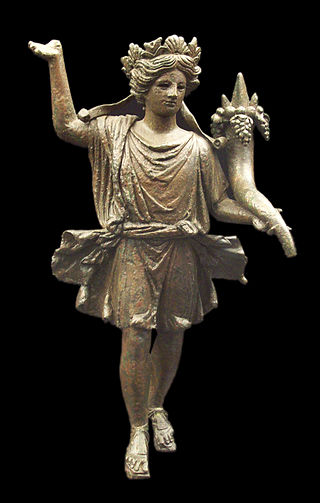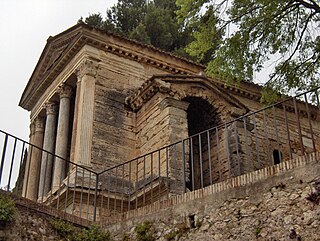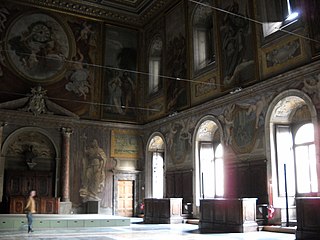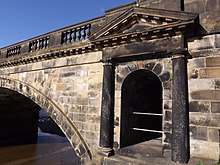
Ancient Greek architecture came from the Greek-speaking people whose culture flourished on the Greek mainland, the Peloponnese, the Aegean Islands, and in colonies in Anatolia and Italy for a period from about 900 BC until the 1st century AD, with the earliest remaining architectural works dating from around 600 BC.

Pediments are a form of gable in classical architecture, usually of a triangular shape. Pediments are placed above the horizontal structure of the cornice, or entablature if supported by columns. In ancient architecture, a wide and low triangular pediment typically formed the top element of the portico of a Greek temple, a style continued in Roman temples. But large pediments were rare on other types of building before Renaissance architecture. For symmetric designs, it provides a center point and is often used to add grandness to entrances.

Lares Familiares are guardian household deities and tutelary deities in ancient Roman religion. The singular form is Lar Familiaris. Lares were thought to influence all that occurred within their sphere of influence or location. In well-regulated, traditional Roman households, the household Lar or Lares were given daily cult and food-offerings, and were celebrated at annual festivals. They were identified with the home to the extent that a homeward-bound Roman could be described as going ad larem.

In architecture, a niche is a recess, a cavity in a wall, typically holding a decorative element: a statue, a vase, etc. In Classical architecture examples are an exedra or an apse that has been reduced in size, retaining the half-dome heading usual for an apse.

The following outline is provided as an overview of and topical guide to classical architecture:

Ancient Roman temples were among the most important buildings in Roman culture, and some of the richest buildings in Roman architecture, though only a few survive in any sort of complete state. Today they remain "the most obvious symbol of Roman architecture". Their construction and maintenance was a major part of ancient Roman religion, and all towns of any importance had at least one main temple, as well as smaller shrines. The main room (cella) housed the cult image of the deity to whom the temple was dedicated, and often a table for supplementary offerings or libations and a small altar for incense. Behind the cella was a room or rooms used by temple attendants for storage of equipment and offerings. The ordinary worshiper rarely entered the cella, and most public ceremonies were performed outside where the sacrificial altar was located, on the portico, with a crowd gathered in the temple precinct.

The Church of Saint Andrew on the Quirinal is a Roman Catholic titular church in Rome, Italy, built for the Jesuit seminary on the Quirinal Hill.
A miniature shrine, also referred to in literature as a portable shrine,pocket shrine, or a travel altar, is a small, generally moveable shrine or altar. They vary greatly in size and architectural style, and by which region or culture produced them.

Lares were guardian deities in ancient Roman religion. Their origin is uncertain; they may have been hero-ancestors, guardians of the hearth, fields, boundaries, or fruitfulness, or an amalgam of these.

Villa Barbaro, also known as the Villa di Maser, is a large villa at Maser in the Veneto region of northern Italy. It was designed and built by the Italian Renaissance architect Andrea Palladio, with frescos by Paolo Veronese and sculptures by Alessandro Vittoria, for Daniele Barbaro, Patriarch of Aquileia and ambassador to Queen Elizabeth I of England and his brother Marcantonio, an ambassador to King Charles IX of France. The villa was added to the list of World Heritage Sites by UNESCO in 1996.

In ecclesiastical architecture, a ciborium is a canopy or covering supported by columns, freestanding in the sanctuary, that stands over and covers the altar in a basilica or other church. It may also be known by the more general term of baldachin, though ciborium is often considered more correct for examples in churches. Really a baldachin should have a textile covering, or at least, as at Saint Peter's in Rome, imitate one. There are exceptions; Bernini's structure in Saint Peter's, Rome is always called the baldachin.

The so-called Temple of Clitumnus is a small early medieval church that sits along the banks of the Clitunno river in the town of Pissignano near Campello sul Clitunno, Umbria, Italy. In 2011, it became a UNESCO World Heritage Site as part of a group of seven such sites that mark the presence of Longobards in Italy: Places of Power.

The Macellum of Pompeii was located on the Forum and as the provision market of Pompeii was one of the focal points of the ancient city. The building was constructed in several phases. When the earthquake of 62 AD destroyed large parts of Pompeii, the Macellum was also damaged. Archeological excavations in the modern era have revealed a building that had still not been fully repaired by the time of the eruption of Mount Vesuvius in 79 AD.

In ancient Roman religion, a sacellum is a small shrine. The word is a diminutive from sacrum. The numerous sacella of ancient Rome included both shrines maintained on private properties by families, and public shrines. A sacellum might be square or round.

The Sala dei Cento Giorni is the largest reception room, the Salone d'Onore on the piano nobile, of the Palazzo della Cancelleria or Chancellery in Central Rome, Italy. The frescoes by Giorgio Vasari and his studio in 1547, epitomize the Mannerist style. Supposedly they were completed in a hundred days.

The Church of Atalaia is a church in the civil parish of Atalaia, municipality of Vila Nova da Barquinha, in the Centro region of Portugal. The Renaissance-era religious building, has been molded by successive layers of Mannerist and Baroque decorative and structural elements, that include the portico, but whose origin dates to the Gothic architecture of the early 16th century. The unique central tower, Baroque azulejo tile-work and 16th century pulpit are important characteristics of this parish church.

The Arch of Caracalla is a Roman triumphal arch located at Djémila in Algeria (Cuicul). It was built during the early 3rd century. The arch, with a single span (fornix), was placed on the road leading to Sitifis. It constituted the entrance to the city's Severan forum.

The Arch of Trajan is a Roman triumphal arch located in the city of Timgad, near Batna, Algeria. It was built between the later 2nd century and the early 3rd century.

The Montemirabile or Saint John the Baptist Chapel, otherwise the Baptistery is the first side chapel in the left aisle in the Basilica of Santa Maria del Popolo.

























